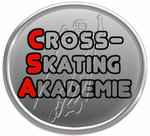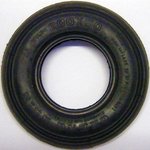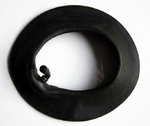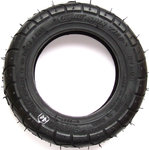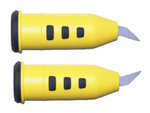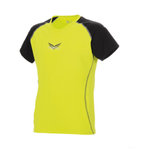Cross-Skate-Shop - SRB, Skitire, Powerlside, SR... Infos about Cross-Skates
Infos about Cross-Skates and other Off-road Skates
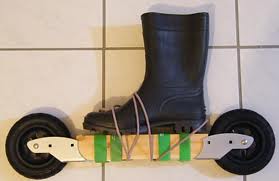
"What are Cross-Skates?"
The word "Cross" initially describes where you can skate: cross, off-road terrain, away from roads. Unfortunately, many tend to misinterpret this and take it as "completely trailworthy" which no Cross-Skate really is. In order to be able to skate reasonably well on off-road terrain it is necessary to at least have adequately sized air tyres - which has also been defined by the Regelwerk Cross-Skating (Cross-Skating Guidelines) since 2005. However, we can be a little more relaxed about this. Some Skates have no air tyres or are not constructed according to these Guidelines, the Rollerblade Coyote and all Cross-Rollerskis with hinged bindings, for example. You can still cross-skate with them and (conditionally) mention them on a par with "genuine" Cross-Skates. However, the exact definition is not an end in itself but necessary for the recognition of the unique features of this sport. And it is indeed very much a sport in its own right - with regard to equipment, skating technique and training methods.
To be more precise: a "real" Cross-Skate always has air tyres and the foot is fixed to the frame along the the whole of its length. Plastic rolls or a hinged binding means that we are dealing with hybrid pieces of sports equipment which have a tendency towards Inline Skating or Rollerskiing.
The two sub-categories of Cross-Skates: With or without shoe
We distinguish roughly between two main types of Cross-Skates: Those Cross-Skates with and those without your own shoes. You could compare this with the difference between an ice-skate and a roller-skate (where you strap in your own shoes). These are two different philosophies, both of which have advantages but also drawbacks:
- Cross-Skates with attached shoe (ie Powerslide XC Trainer)
+ Shoe firmly mounted onto the frame - foot is always in close contact with the skate.
+ Shoes are often very stable, which can support the ankle joints.
- If the shoe does not fit, it needs to be exchanged, which is expensive. Also, sometimes the shoes are too stiff to lift the forefoot properly.
- In the case of a puncture or if you just want to stop at the ice cream parlour, separate shoes need to be carried along.
- Cross-Skates without attatched shoe (ie Skike V07)
+ You can continue with your own shoes (whether that is part of the itinerary or not).
+ More flexibility in your choice of shoe. Therefore, possibly more comfort of foot. More flexibility of the shoe allows for better skating style.
± The ankle joint will have to learn stability, which can be a bit tricky at first but will prove a beneficial skill after a while.
- The skate will have to be exactly adjusted to the (suitable!) shoe in order to enable the cross-skater to skate as precisely as possible. Not all Cross-Skates provide a permanently close contact between shoe and frame (ie the VX series does not).
Differences in wheelbase: Short and long skates
There are short skates, which are built as short as possible: Skike VX, Skike V07, Fleetskates, Powerslide XC Trainer. And there are long Skates significantly larger wheelbase like the Powerlside XC Path or the SRB Cross-Skate XRS02. Trailskates are somewhere in between.
Beginners often feel more comfortable on short skates (at least for the first few hour of cross-skating), because these respond more directly to technical corrections. As their skating style gets better, skaters tend to go more for longer wheelbases. Nevertheless, those with shoe sizes 39 or 40 and adjustable cross-skates like the Skike V07, will sooner or later adjust their wheelbase to that for shoe sizes 45 to 48 and still feel safe and comfortable with that. Those with smaller foot sizes are lucky enough that their skates will "grow" along with their skating ability. Skaters with a shoe size of 43 and above aren't that lucky and will probably need long skates. This does not mean that it is a mispurchase for a beginner to chose long skates. The fact that the long skates require a little bit more patience to learn but the benefits are better directional stability and safety.
Two brakes, one brake or even no brake?
Only those who exclusively train away from public areas can risk skating without a brake. Most of us, however, want to get around a bit whilst not taking any unnecessary risks on off-road terrain, in traffic and in unfamiliar areas. It is not just about controlled, scheduled braking where a single brake might just be sufficient. It is about about spontaneous braking which requires the best technology can offer. Moreover, almost all advanced beginners know the value of a calf brake as a protection from falling backwards. It will act automatically if firstly the brake is adjusted correctly (quite tight) and secondly if brakes are installed on both skates. You are never going to know in advance whether it is your left or your right skate you might lose control of - resulting in a skate "slipping forward" - a calf brake will almost always save this situation. With two calf brakes you will hardly ever fall on your bum! You also double the braking action as well as the time it takes until a brake will overheat.
Lightweight vs. heavy Skates?
It is probably the same with all vehicles: How much can I attach to the vehicle until it becomes immobile. You could probably make an extreme comparison between an SUV off-terrain tank and a racing cart or between a 30-kg-E-Bike and an 8 kg racing bike. While the former offers all the comfort you could wish for, but because of its consistency, the latter is a lot more sportive and the performance is better even though it "lacks" equipment. It is a matter of personal preference. There are Cross-Skates weighing between 1,7 kg and 4,0 kg - taking into consideration the extra weight of about 500 g for shoes for skates without attached shoes. We are not saying that every little gram counts but the weight on your feet is perceived to be five times heavier than the weight on your back. Also, added weight on your feet will not only make skating more difficult but also less precise and, therefore, more dangerous - whether the heavy skates are more stable or not. Of course, an ultra-light skate which tends to break is not the solution, either. Generally, however, we were able to collect some facts based on the experience of more than a thousand customers:
Most skaters believe that 2,3 and 2,7 kg per skate (always including shoes) is sufficient for sporty skating. Any Skates beneath this weight are considered to be "ultra-light" and anything above to be "slow", even as dangerously slow by some. As examples, take a look at a pair of Skike V07 plus shoes (= about 2,5 kg per skate) or the Powerslide XC Path (= about 2,55 kg per skate, shoes are included).
Fat-Tyre-, Mid-Tyre-, Narrow-Tyre-Skate? Fette, mittelbreite oder Schmalspur-Skates?
Unfortunately, the manufacturers lag behind the practical tests (Cross-Skate-Shop projects, especially between 2008 and 2010) and do not offer enough tyre widths.


